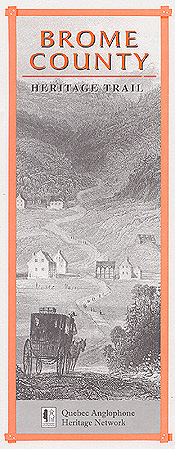
The border county of Brome in Quebec’s Eastern Townships overspreads a swath of Appalachian country from the Sutton Mountains to Lake Memphremagog. Renowned for its lakes and mountains, the region also has strong historical ties that reach across the international boundary.
Many early Brome settlers were Loyalists from New England who had fought with or helped British forces during the American Revolution and left or lost their homes by war’s end. When Britain opened the area to settlement in 1792, these settlers pushed east along the Missisquoi River from Missisquoi Bay into the new townships of Sutton, Potton and Bolton.
New England pioneers knew the hardships of frontier life and brought valuable skills to what was then called Lower Canada (Quebec). They cleared land, made potash, cut roads, raised crops and built mills.
With the coming of the railway, some of these settlements grew into thriving mill towns and transportation centres in the 19th and early 20th centuries. Tourism has now supplanted agriculture as the region’s economic mainstay.
GETTING THERE
This Heritage Trail touches 12 pioneer settlements, landmarks and points of interest between Brome Lake and the Quebec-Vermont border. From Montreal or Sherbrooke follow Autoroute 10 to Waterloo and exit south onto Rte. 243.
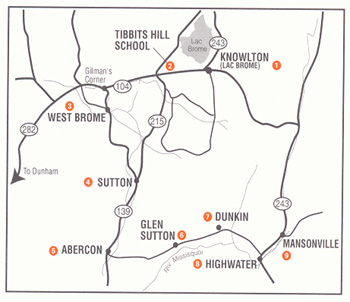 KNOWLTON
KNOWLTON
(Pop. 1,800)
An early mill town that flourished in the 1800s, Knowlton treasures its Loyalist history and has carefully preserved it. Today Knowlton is a major tourist hub, offering pleasant amenities for visitors.
The Brome County Historical Museum on Lakeside Rd (Rte. 243) occupies Knowlton’s first public school building, Knowlton Academy (1854), and features Indigenous artifacts, pioneer furniture and relics of early rural education. A historic walking-tour guide, available at the museum, describes Knowlton’s Victorian architecture.
 The village name honours Col. Paul Holland Knowlton. Massachusetts-born and of Loyalist stock, Knowlton served as the area’s Member of Parliament for Lower Canada from 1830 to 1834. The village grew up around a dam and flour mill he built on Cold Brook in 1836. The original millstone is on display in a picnic area by the spillway off Lakeside Rd (Rte. 243). Across the street is the fieldstone house built by tanner Israel England in 1852.
The village name honours Col. Paul Holland Knowlton. Massachusetts-born and of Loyalist stock, Knowlton served as the area’s Member of Parliament for Lower Canada from 1830 to 1834. The village grew up around a dam and flour mill he built on Cold Brook in 1836. The original millstone is on display in a picnic area by the spillway off Lakeside Rd (Rte. 243). Across the street is the fieldstone house built by tanner Israel England in 1852.
When wealthy Montrealers began to build country villas in the village in the late 1800’s, Knowlton was spared the economic decline felt in other rural mill towns.
TIBBITS HILL PIONEER SCHOOL
Traveling west along Rte. 104, the Trail soon reaches Tibbits Hill Rd. Turning right leads to the Old South Schoolhouse. Built in 1844, the one-room fieldstone structure served English-speaking pupils until 1928. Managed by the Brome County Historical Society, the school contains many period furnishings. Open to visitors every Sunday from June to August, between 2 p.m. and 4:30 p.m., or by appointment.
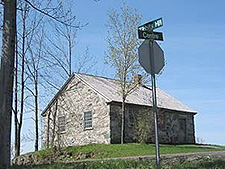 Brome County Historical Society and Museum:
Brome County Historical Society and Museum:
(450) 243-6782
130 Lakeside, Knowlton
WEST BROME
(Pop. 700)
The juncture of Routes 104 and 139 is known as Gilman’s Corner. Here turn south along Rte. 139 toward historic West Brome Village on the Yamaska River. This community was built around a mill complex on the river that included a wool factory, a sawmill and a flour mill run by the Hungerford family in the 1800s. The original family house sits opposite the prominent Anglican Church of the Ascension. Be sure to visit the F. G. Edwards General Store on McCurdy Rd., changed little since first opening in 1852.
A short side-trip shows two interesting landmarks: a rare round barn and a marker erected where Brome Township’s first settler, Henry Collins, built his house in 1795. From the main intersection (Rte. 139) follow Scott Rd.. past the round barn to Miltimore Rd., and turn left. The Collins marker sits in the field on the left side of the road near the top of the hill.
SUTTON
(Pop. 1,617)
The most scenic approach to this mecca for outdoors enthusiasts is by way of Draper Hill Rd. off Rte. 139. This stretch of gravel road passes the North Sutton pioneer cemetery. Further on, the Trail comes to a stone farmhouse at the corner of Draper Hill and Woodward roads. The house was built around 1834 by Horace Sweet, a settler from New York whose family mined local copper for sale south of the border during the U.S. Civil War.
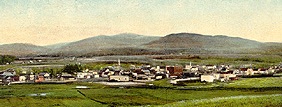 The Sweet Cemetery on Woodward Rd. offers a magnificent view of the Sutton Mountains. To reach the village, follow Woodward down into the valley. The visitor information bureau at 11 rue Principale provides a guide to 16 historic buildings in the village. The Edbert Museum of Communications at 30A rue Principale features an interesting display of communications technology.
The Sweet Cemetery on Woodward Rd. offers a magnificent view of the Sutton Mountains. To reach the village, follow Woodward down into the valley. The visitor information bureau at 11 rue Principale provides a guide to 16 historic buildings in the village. The Edbert Museum of Communications at 30A rue Principale features an interesting display of communications technology.
Originally known as Sutton Flats, Sutton got its start around 1800 when William Huntingdon erected mills on the river near the site of the town hall. Local dairy and lumber industries developed in the 1860s with the arrival of the South Eastern Counties Junction Railway, which later became part of the Canadian Pacific Railway (CPR).
Sutton Tourism: 1 (800) 565-8455 / (450) 538-8455
Website: www.info-sutton.qc.ca
Edbert Museum of Communications: (450) 538-3222
ABERCORN VILLAGE
(Pop. 330)
Known as the cradle of Sutton Township, this hamlet lies a stone’s throw from the Vermont border. It was here beside the Sutton River that New Hampshire Loyalist Thomas Shepard settled in 1792. Just east of the main crossroads on Chemin des Églises, the Trail passes a plaque marking the Old Abercorn Cemetery (1809).
For many years Abercorn was known simply as Shepard’s Mills. A drive south through the village on Thibeault St. leads past historic homes to a bridge overlooking the waterfalls where the township’s first lumber and grist mills stood. In 1845, a Customs House and telegraph office began operations nearby, followed by a post office in 1848.
By 1870, Abercorn was a busy border town with many stores, a forge and two churches. With the arrival of the railway, the community prospered as a forwarding point for milk shipments.
During the Prohibition years in the U.S., a village farmhouse known as the Pinetree Inn became a favourite watering hole with thirsty American patrons. Today, visitors are drawn to the famous Abercorn Bakery.
GLEN SUTTON
Allan Edson, a renowned 19th-century landscape painter, found inspiration for his art in the hills and forests of his native Townships. This pastoral settlement on the Missisquoi River is where he lived and worked in the 1880s.
From Abercorn, the Trail follows a spectacular mountain gorge down into the Missisquoi Valley. Until 1846, the route was little more than a footpath and Glen Sutton never attracted large numbers of settlers. Nevertheless, homesteaders led by James Miller built a school in 1823 and a public house in 1836. Preachers paddled upriver in canoes from Richford, Vermont.
A historical marker on the Missisquoi Valley Rd., just east of the village marks the site of the Good Shepherd Anglican Church (1877), which was sold in 1999 and made into a concert hall.
DUNKIN
(Pop. 100)
Col. Hendrick Ruiter occupies a special place in the Loyalist lore of the Eastern Townships. After siding with British forces, the New York native spent months hiding from American rebels near Albany. He later joined a failed attack on a rebel stronghold at Bennington, Vermont, and spent the rest of the war spying, scouting and plotting raids south of the border. Ruiter’s loyalty stood him in good stead: this hamlet is where he built his house and grist mill in 1796 after gaining title to 27,000 acres of land.
Dunkin was once a prosperous logging community. Wood was floated down the Missisquoi River to Richford. In the early 20th century, the Singer Sewing Machine Company ran a logging camp on Ruiter Brook Rd to supply cabinet wood for its factory at St. Jean-sur-Richelieu.
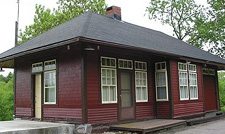 Dunkin’s heritage buildings are lost or collapsing, victims of a vanished farm economy. A dilapidated church, the ruins of a blacksmith shop and a junk shed that once was a general store tell of better times. A historic schoolhouse survives, however, remodeled as a private home. Painted blue, the building sits on Sargent Rd, a few metres from the highway.
Dunkin’s heritage buildings are lost or collapsing, victims of a vanished farm economy. A dilapidated church, the ruins of a blacksmith shop and a junk shed that once was a general store tell of better times. A historic schoolhouse survives, however, remodeled as a private home. Painted blue, the building sits on Sargent Rd, a few metres from the highway.
HIGHWATER
(Pop. 125)
According to tradition, this fork in the river where the north and south branches of the Missisquoi meet was the western end of an ancient portage between Lake Champlain and Lake Memphremagog. First called South Potton, the hamlet developed with the coming of the railway in 1873.
During Prohibition, Highwater hotels did a booming trade serving liquor to American clients. In the 1970s and 1980s, a rocket scientist and international arms dealer named Gerald Bull employed 200 workers at his Space Research Corporation complex here. Bull was developing a long-range cannon prior to his assassination in Europe in 1990.
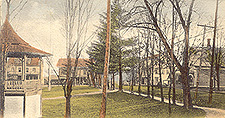 MANSONVILLE
MANSONVILLE
(Pop. 550)
This village takes its name from a prominent pioneer family whose descendants still live in the area. At the bottom of Mill St., the stone abutments of Robert Manson’s mill complex can still be seen. Manson was a Loyalist entrepreneur who ran a saw mill and grist mill on the Missisquoi River, starting in 1811.
The Potton Heritage Association has put together a series of guides to area landmarks, including a historic walking tour of the village. Obtain copies at the local tourist bureau, located in Reilly House (circa 1850) at 302 rue Principale.
Guided tours are available through the Association at (450) 292-3020.
Reilly House: (450) 292-3109
The Heritage Trail series is presented by the Quebec Anglophone Heritage Network, funded jointly by the Department of Canadian Heritage and Economic Development Canada. Space constraints preclude mention of all possible sites. Thanks to Marion Phelps and the Brome County Historical Society. For more information, call the QAHN office at (819) 564-9595 or toll-free within Quebec at 1 (877) 964-0409.![]()
![]()